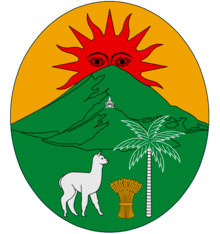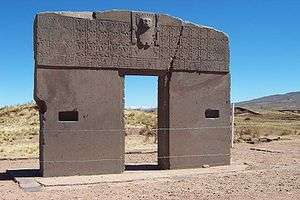Pre-Columbian Bolivia
Part of a series on the |
|---|
| History of Bolivia |
 |
|
|

Pre-Columbian Bolivia covers the historical period between 10,000 BCE, when Upper Andes region was first populated and 1532, when Spanish conquistadors invaded Inca empire. The Andes region of Pre-Columbian South America was dominated by the Tiwanaku civilization until about 1200, when the regional kingdoms of the Aymara emerged as the most powerful of the ethnic groups living in the densely populated region surrounding Lake Titicaca. Power struggles continued until 1450, when the Incas incorporated upper Bolivia into their growing empire. Based in present-day Peru, the Incas instituted agriculture and mining practices that rivaled those put in place many years later by European conquerors. They also established a strong military force and centralized political power. Despite their best efforts, however, the Incas never completely controlled nomadic tribes of the Bolivian lowlands, nor did they fully assimilate the Aymara kingdoms into their society. These internal divisions doomed the Inca Empire when European conquerors arrived.[1]
Earliest cultures
Cultures of indigenous peoples in Bolivia developed in the high altitude settings of altiplano with low oxygen lewels, poor soils and extreme weather patterns. The better suited lowlands were sparsely inhibited by hunter-gatherer societies while much of the pre-Columbian population was concentrated in altiplano valleys of Cochabamba and Chuquisaca.
Potato was domesticated near lake Titicaca between 8000 and 5000 BC, quinoa some 3000–4000 years ago and production of copper began in 2000 BC. Llama, alpaca and vicuña were domesticated and used for transport, food and clothing.
The site of Jisk'a Iru Muqu was first investigated in 1994. A necklace consisting of nine gold beads was found in an excavated grave located next to a Terminal Archaic pit house. Charcoal recovered from the burial dates the gold beads to 2155-1936 cal BC[2]
The earliest cultures in Bolivia are the Wankarani culture, and the Chiripa. The earliest Wankarani sites are dated from 1800 BC onwards.[3] Wankarani culture arose in the area of Oruro Department near Lake Poopo.
Pre-Columbian cultures in Bolivia
Tiwanaku empire
Situated in Western Bolivia its capital city of Tiwanaku dates as early as 1200 BC as a small agricultural village.[4] In around 400 Tiwanaku empire began expansion, reaching into Yungas and establishing contacts with other cultures in Peru, Bolivia and Chile. By 600 it became an important regional power in the southern Andes.[5] Tiwanako underwent a dramatic transformation between 600 and 700 that established new monumental standards for civic architecture and greatly increased the resident population.[6]
Tiwanaku empire absorbed cultures rather than eradicated them. Archaeologists have seen a dramatic adoption of Tiwanaku ceramics in the cultures who became part of the empire. Tiwanaku gained its power through the trade it implemented between all of the cities within its empire.[5] The elites gained their status by the surplus of food they gained from all of the regions and then by having the ability to redistribute the food among all the people. This is where the control of llama herds became essential, for carrying goods back and forth between the center and the periphery.
In about 950 a dramatic shift in climate occurred.[7] A significant drop in precipitation in the Titicaca Basin followed. Many cities further away from Lake Titicaca began to produce less crops to give to the elites. The capital city became the last place of production, due to the resiliency of the raised fields, but in the end even the intelligent design of the fields was no match for the weather. Tiwanaku disappeared around year 1000 because food production, its main source of power, dried up. The land was not inhabited for many years after that.[7]
Aymara kingdoms

Between 1100 and 1460 Aymaras developed a number of kingdoms around lake Titicaca, of which Lupaca, Colla and Cana were the largest. They lived farther inland, in fortified towns (pucara) and built chullpa burial and ceremonial towers. Aymaras prospered in the harsh altiplano conditions, but also controlled lands on eastern slopes of Andes that were more suited for food production – they had colonies in lowland temperate and semitropical areas, in order to grow food and sustain their populations. This society type has been called the vertical archipelago.
Aymara society was organized in ayllus, kinship groups.[8] Ayllu was divided in two strata – upper (hanansaya) and lower (urinsaya). Aymaras controlled and dominated the Uru and Puquina people, who had lived in the Andean region before Aymaras, but by the 12th century were reduced to a status of oppressed landless workers for Aymaras. Aymara dominance in the region was challenged by the growing state of Quechuas from Cuzco which conquered them between 1460 and 1500.
Inca empire

Incas conquered much of what is now western Bolivia under their ninth emperor Pachacuti Inca Yupanqui, whose reign lasted from 1438 to 1471. Pachacuti Yupanqui was succeeded by his son Topa Inca Yupanqui whose reign lasted from 1471 to 1493. Western Bolivia became a part of the Inca territory as Qullasuyu, one of the four parts of the empire with estimated one million inhabitants living here.[9]
The highest official of Qullasuyu was responsible only to the Inca (the emperor) and supervised a group of provincial governors, who in turn controlled members of the Aymara nobility. Under a draft system called the Mit'a, Incas forced people to work in mines or on construction projects or to serve in the armies, while compensating them fully for their labor.[8]
Despite their policy of extreme centralization, Incas did not fundamentally change the organization of Aymara kingdoms, which remained relatively autonomous. Many local chiefs kept many of their powers and were, in general, reinforced by Inca authority. They were also able to retain their culture, their local religion, and their language. The regional nobility, although forced to send their children to Cuzco for education, continued to hold private property. Moreover, the system of sending colonists to the eastern valleys and the coast was tolerated under Inca rule.[8]
In 1470 several Aymara kingdoms rebelled against Incas. The Incas completely defeated two states and pacified the region by sending mitimas, Quechua-speaking colonists, to Aymara territory, especially to the southern valleys and to the more central valley regions where Cochabamba and Sucre were later founded. By the beginning of the 16th century Incas had fully secured their rule.[8]
Incas failed, however, to conquer the nomadic tribes in the eastern Bolivian lowlands. The remains of Incan fortresses here are evidence of this failure and suggest that Incas could subdue only those cultures that were based on agriculture. Thus the Indian tribes of the eastern lowland two-thirds of Bolivia preserved their ways of life to a great extent, even after the Spanish conquest.[8] Moxo people built elevated causeways here to manage the regular floods and to support their population.
See also
References
- ↑ Country Profile: Bolivia (PDF). Library of Congress Federal Research Division (January 2006).
 This article incorporates text from this source, which is in the public domain.
This article incorporates text from this source, which is in the public domain. - ↑ Aldenderfer, Mark; Craig, Nathan M.; Speakman, Robert J.; Popelka-Filcoff, Rachel (2008), "Four-thousand-year-old gold artifacts from the Lake Titicaca basin, southern Peru", Proceedings of the National Academy of Sciences, 105 (13): 5002–5, Bibcode:2008PNAS..105.5002A, JSTOR 25461542, PMC 2278197
 , PMID 18378903, doi:10.1073/pnas.0710937105
, PMID 18378903, doi:10.1073/pnas.0710937105 - ↑ Jason (Jake) R. Fox, Time and Process in an Early Village Settlement System on the Bolivian Southern Altiplano. PhD Thesis 2007
- ↑ Fagan, Brian M. 'The Seventy Great Mysteries of the Ancient World: Unlocking the Secrets of Past Civilizations'. New York: Thames & Hudson, 2001.
- 1 2 McAndrews, Timothy L. et al. "Regional Settlement Patterns in the Tiwanaku Valley of Bolivia". Journal of Field Archaeology 24 (1997): 67–83.
- ↑ Isbell, William H. 'Wari and Tiwanaku: International Identities in the Central Andean Middle Horizon'. 731–751.
- 1 2 Kolata, Alan L. 'The Tiwankau: Portrait of an Andean Civilization'. Blackwell Publishers, Cambridge, 1993.
- 1 2 3 4 5 Hudson, Rex A.; Hanratty, Dennis Michael (1991). "Historical Setting". Bolivia: A country study (Third ed.). Library of Congress Federal Research Division. pp. 6–7. LCCN 90026427.
 This article incorporates text from this source, which is in the public domain.
This article incorporates text from this source, which is in the public domain. - ↑ A Concise History of Bolivia
